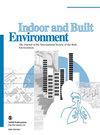Evaluation of heating performances of different ventilation methods in an office
IF 2.9
3区 工程技术
Q2 CONSTRUCTION & BUILDING TECHNOLOGY
引用次数: 0
Abstract
In this study, 12 cases were investigated in an office-layout room using experiments and computational fluid dynamics (CFD) simulations. The heating performances of four ventilation methods (i.e. mixing ventilation (MV), stratum ventilation (SV), deflection ventilation (DeV) and impinging jet ventilation (IJV)) were comprehensively compared by various evaluation indexes (i.e. predicted mean vote (PMV), draught rate (DR), vertical air temperature difference (△T), air diffusion performance index (ADPI), energy utilization coefficient (EUC), air change efficiency (ACE) and contaminant removal efficiency (CRE)). Better thermal comfort was found in rooms heated by SV and DeV. The PMV, DR and △T under SV and DeV complied with Category B of ISO 7730:2005, and the ADPI was in full compliance with the stipulation of ANSI/ASHRAE 113-2022. For the energy-saving characteristic, the targeted-occupied-zone ventilation methods (i.e. SV, DeV and IJV) can effectively deliver warm air to the occupied zone, with the EUC values higher than unity and thus providing a good potential for energy saving. SV and IJV showed slightly higher ACEs in the breathing zone. The contaminant removal effectiveness of SV, DeV and IJV was comparable. Under the combined influence of occupant thermal plumes and locations of exhausts, MV showed a high CRE. However, the CRE under MV decreased significantly when the exhausts were not above occupants. In the case of supply air parameters in this study, the entropy-weight method indicated that DeV and SV had a better overall performance for winter heating, followed by IJV and then MV.某办公室不同通风方式采暖性能评价
在本研究中,采用实验和计算流体力学(CFD)模拟的方法对12个案例进行了调查。通过预测平均票数(PMV)、风量(DR)、垂直空气温差(△T)、空气扩散性能指数(ADPI)、能量利用系数(EUC)、换气效率(ACE)和污染物去除效率(CRE)等评价指标,对混合通风(MV)、地层通风(SV)、偏转通风(DeV)和冲击射流通风(IJV) 4种通风方式的采暖性能进行综合比较。SV和DeV两种加热方式的室内热舒适性较好。SV和DeV两种加热方式下的PMV、DR和△T符合ISO 7730:2005的B类标准,ADPI完全符合ANSI/ASHRAE 113-2022的规定。在节能方面,目标占用区通风方式(即SV、DeV和IJV)可以有效地将热空气输送到占用区,EUC值大于1,具有良好的节能潜力。SV和IJV呼吸区ace略高。SV、DeV和IJV对污染物的去除效果相当。在乘员热羽流和排气位置的综合影响下,MV表现出较高的CRE。然而,当废气不高于乘员时,MV下的CRE显著下降。以本研究送风参数为例,熵权法分析表明,DeV和SV对冬季采暖的综合性能较好,IJV次之,MV次之。
本文章由计算机程序翻译,如有差异,请以英文原文为准。
求助全文
约1分钟内获得全文
求助全文
来源期刊

Indoor and Built Environment
环境科学-工程:环境
CiteScore
6.40
自引率
25.00%
发文量
130
审稿时长
2.6 months
期刊介绍:
Indoor and Built Environment publishes reports on any topic pertaining to the quality of the indoor and built environment, and how these might effect the health, performance, efficiency and comfort of persons living or working there. Topics range from urban infrastructure, design of buildings, and materials used to laboratory studies including building airflow simulations and health effects. This journal is a member of the Committee on Publication Ethics (COPE).
 求助内容:
求助内容: 应助结果提醒方式:
应助结果提醒方式:


